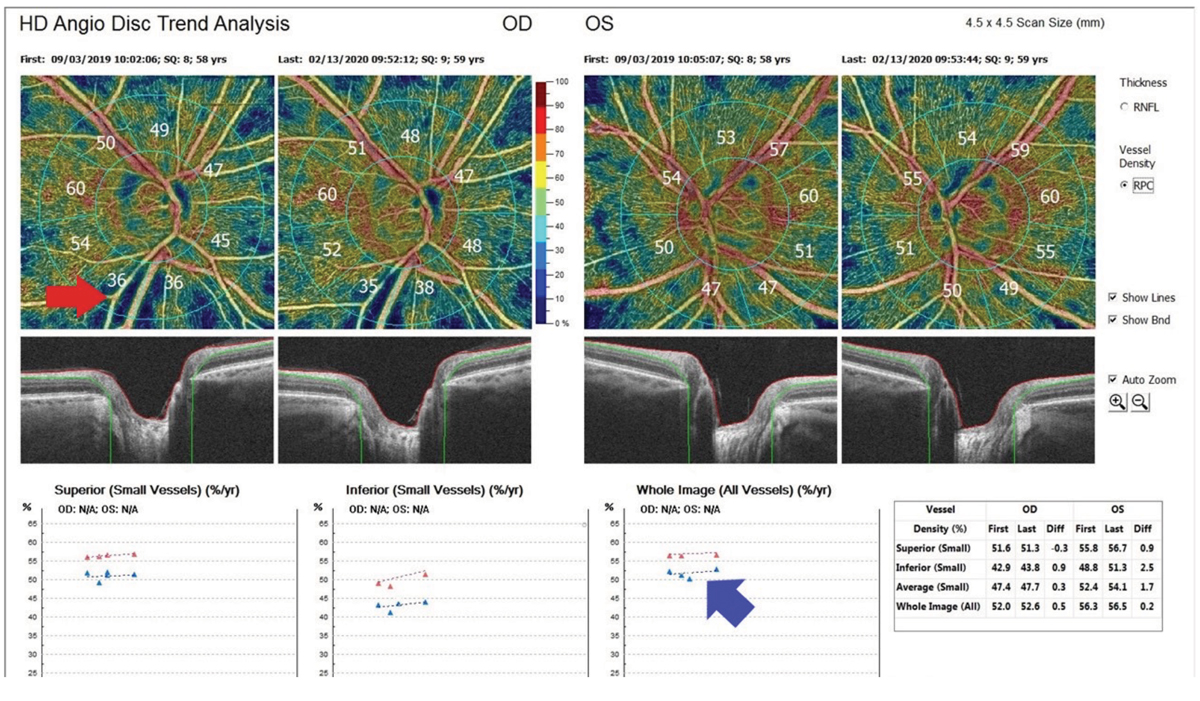 |
|
A history of greater smoking consumption was associated with faster vessel density loss over time. Authors of this study suggest that smoking intensity should be considered when assessing the risk of glaucoma progression, as well as its management. (Image from a different patient than those studied.) Photo: Michael Cymbor, OD. Click image to enlarge. |
The health consequences of habitual smoking are of course well known in pulmonary and cardiovascular disease, but its association with primary open-angle glaucoma (POAG) remains inconclusive despite extensive study over the years. To get a clearer picture of this association, researchers from UC San Diego investigated the relationship of smoking and smoking intensity with the rate of optic nerve head whole image capillary density loss in primary open angle glaucoma (POAG) and glaucoma suspect patients. They found that a lifetime history of greater smoking consumption was associated with faster vessel density loss overtime and that smoking could be a potential risk factor for glaucoma.
POAG patients who had at least two years of follow-up and OCT angiography (OCT-A) performed at a minimum of four visits were selected. In total, 164 eyes (69 glaucoma suspects and 95 POAG) of 110 patients were included with a mean follow-up of four years. Of the 110 patients, 45.5% had a reported history of smoking. The smoking intensity was calculated as the pack-year at the baseline OCT-A. Various statistical measures were used to determine the effect of each parameter on the rates of capillary density loss over time.
Greater pack-years of smoking, rather than just smoking history, was associated with dose-related vessel density loss. The rate was faster in heavy smokers (l >20 lifetime pack-years) and smoking intensity tended to be associated with circumpapillary retinal nerve fiber layer loss over time.
Rates of vessel density loss were different among patients who have never smoked. However, for every additional 10 pack-years of smoking, there was a 0.1%/year increase in the rate of vessel density loss. “Although the effects of smoking may appear modest, these results highlight its potential role as a modifiable risk factor affecting both structural and vascular factors,” the authors explained.
Previous studies using OCT-A have shown conflicting results on the acute effects of smoking on optic nerve and macular perfusion, with one showing reduced blood flow in choriocapillaris an hour after smoking while others found no immediate changes in vessel density among healthy habitual smokers.
“Our findings, however, indicate that greater smoking intensity is associated with faster vessel density loss over an average of four years,” the researchers wrote in a recent paper for Journal of Glaucoma. “This could be attributed to microinfarctions and capillary non-perfusion, leading to compromised capillary blood flow. Autopsy results of smokers have indicated fibrous thickening of blood vessel walls, even in tissues not directly exposed to smoke. Overall, the acute and chronic effects of smoking on the vascular system and tissue are multifaceted, and these effects may be more pronounced in glaucoma patients with additional risk factors.”
Based on these results, the authors suggest that smoking intensity should be considered when assessing the risk of glaucoma progression and management.
Nishida T, Weinreb RN, Tansuebcheasai N, et al. Smoking intensity is associated with progressive optic nerve head vessel density loss in glaucoma. J Glaucoma. April 23, 2024. [Epub ahead of print]. |

